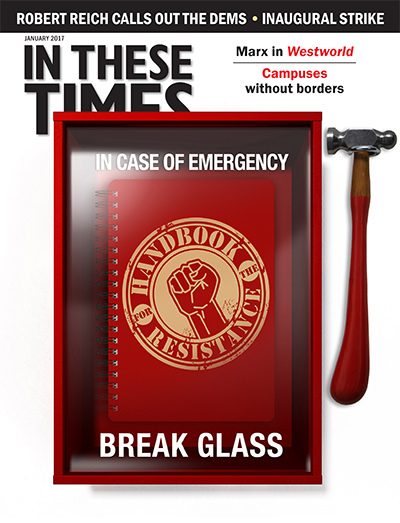The Only Way to Defeat Trump Is to Understand That Race and Class Are Inseparable
Solidarity is key to building a multiracial working-class movement.
Saqib Bhatti

In postelection strategy meetings, progressives everywhere are asking: Should we organize around race or class? Inevitably, someone answers, “Of course, we need to do both.” Heads nod. I disagree. The answer is not “both,” which presumes they are separable. Because racial division is a critical tool of class oppression, we cannot address one without the other.
Most economic justice organizers on the Left, myself included, organize people of color around both race and class, but not white folks around race. In fact, we actively avoid it — with a few notable exceptions, like the faith-based group ISAIAH, which has successfully organized predominantly white churches in the Minnesota suburbs against racism.
When we talk about how the system is set up to help rich people and hurt poor people, we mostly confine our racial analysis to the subpoint that communities of color are hurt more. But the reality goes beyond that: We must talk more about how wealthy, powerful people of all races (and the corporations they control) incite racism to win support for regressive economic policies. For example, the Right paints single Black mothers as “welfare queens” to gain white support for gutting programs like food stamps, even though the overwhelming majority of food stamp recipients are white.
Poor white people are also harmed by corporate practices that are rooted in structural racism, like the sale of subprime mortgages. Banks and mortgage lenders aggressively targeted Black and Latino families with predatory subprime loans that were overpriced and highly risky. According to affidavits by workers at Wells Fargo, subprime mortgages were referred to within the bank as “ghetto loans” and their recipients called “mud people.”
But even though banks targeted Black and Latino families for subprime mortgages, and these families were more likely than their white counterparts to receive them, the overwhelming majority of families who received subprime mortgages were white — and millions lost their homes.
Poor white families do benefit from their whiteness in countless ways, but those benefits haven’t been enough to lift them out of poverty. They’ve been outweighed by the harm done by a slew of policies and practices, from Medicaid cuts and the dismantling of public housing, that were sold through racism. Whether explicitly or via dog whistles, the Right invokes race to divert blame from the ruling class for eroding white working-class people’s livelihoods and prospects. Donald Trump just won an election by scapegoating Black people, Latinos and Muslims, among others, as the culprits that made America not “great.”
In response, the Left must go on offense and name the real villains: those who are using race to enrich themselves at the expense of poor people of all races. One such villain will soon be in charge of our nation’s economy. Steve Mnuchin, Trump’s nominee to lead the Treasury Department, ran a foreclosure machine that kicked thousands of families to the curb, earning him the moniker “foreclosure king.” Families all across the country personally know people who lost their homes as a result.
Because economic and political power is so heavily concentrated, finding common enemies should not be hard. In September 2016, MHAction, which organizes in manufactured, or mobile, home communities, brought its predominantly white members from eight states to Manhattan to join New York Communities for Change’s predominantly Black and Latino members to disrupt a high-powered real-estate conference. The conference featured private equity tycoons like Sam Zell who are buying up manufactured home communities in suburban, exurban and rural areas, as well as affordable rental units in cities, and evicting their residents.
Such actions lay the foundation for a multiracial movement of working-class families who understand that none of us will ever be free until we dismantle white supremacy.
Saqib Bhatti is the Executive Director of the Action Center on Race & The Economy.









